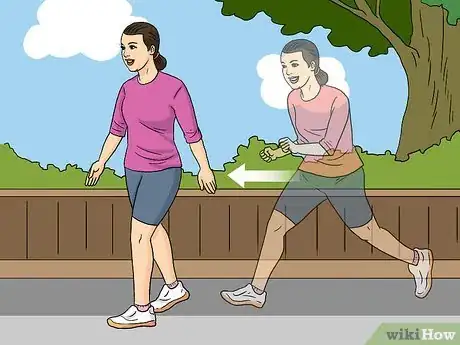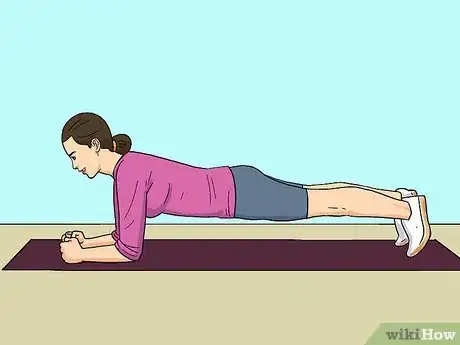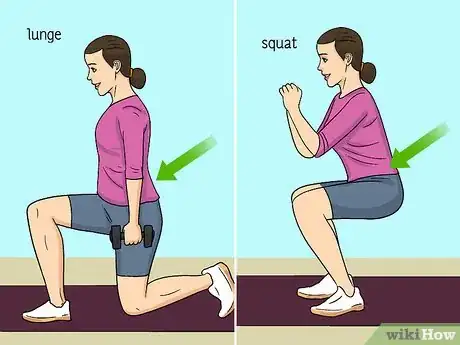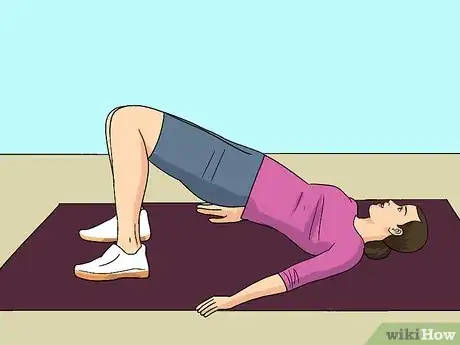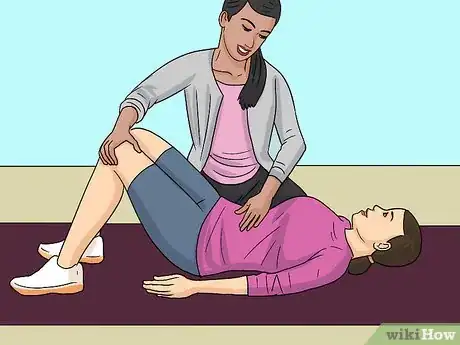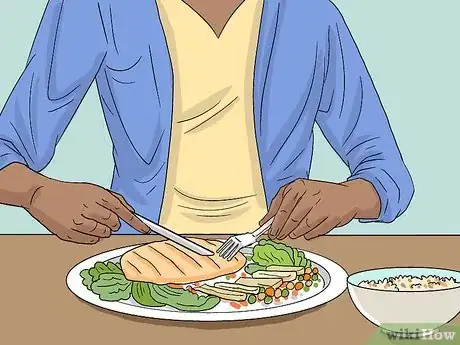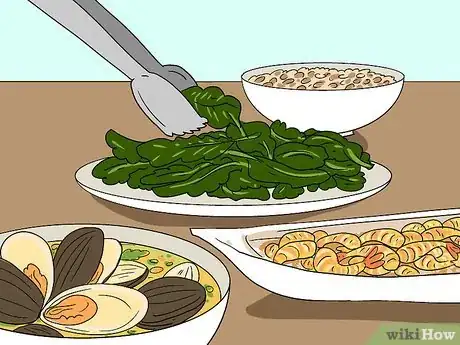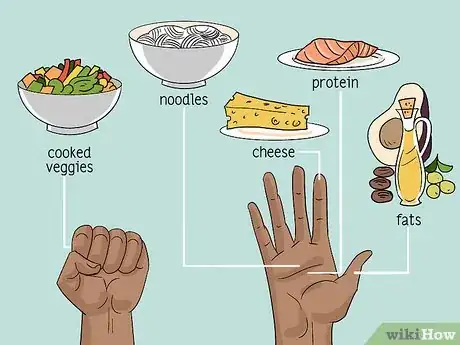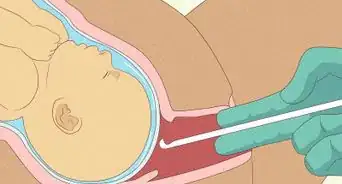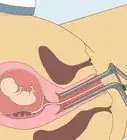This article was co-authored by Laila Ajani. Laila Ajani is a Fitness Trainer and founder of Push Personal Fitness, a personal training organization based in the San Francisco Bay Area. Laila has expertise in competitive athletics (gymnastics, powerlifting, and tennis), personal training, distance running, and Olympic lifting. Laila is certified by the National Strength & Conditioning Association (NSCA), USA Powerlifting (USAPL), and she is a Corrective Exercise Specialist (CES).
There are 14 references cited in this article, which can be found at the bottom of the page.
This article has been viewed 135,214 times.
Every woman’s body responds differently after pregnancy. How much weight you gained while pregnant, whether or not you breastfed, and your diet and exercise habits all affect your post-baby body. Focus on toning your abdominals via exercise and changing your diet to get rid of a lingering pregnancy belly. But try not to get down on yourself about having a belly. Remember, you did something amazing by carrying a baby!
Steps
Exercising for a Flat Belly
-
1Do cardiovascular exercise for 30 to 40 minutes 5 to 7 days a week. Go for a walk, jog, or run for at least 30 or 40 minutes most days of the week. Not only will cardio help you shed excess belly fat, but it will make you feel more confident and energetic![1]
- Choose something you enjoy so you’re likely to stick with it.
- Change up the intensity of your exercises via interval training to keep your body guessing. For instance, alternate between walking, jogging, and running in a single workout session.
-
2Do planks to strengthen your core muscles. Assume a push-up position with your elbows resting on the floor and your forearms bent at a 90-degree angle. Keep your elbows directly under your shoulders and look straight down toward the floor. Flex your abdominals and hold this position for 30 to 60 seconds at a time (or longer, if you can).[2]
- Start by doing 3 to 4 sets of 30-second planks per day and adding 10 to 15 seconds as you notice planking becomes easier.
- Only your toes, elbows, and forearms should be touching the floor.
- Your body should make a straight line; avoid letting your back sag down or round up.
Advertisement -
3Perform transverse holds to strengthen your transverse abdominis muscles. Flex to suck in your belly like you’re trying to fit into a tight pair of jeans. Notice that your belly button will go slightly inward toward your spine. Hold this contraction for 5 to 10 seconds before relaxing to make 1 rep. Do about 3 sets of 10 to 12 reps per day.[3]
- You can feel your transverse abdominis muscles engaging when you say “shhh.”[4]
- Do transverse holds while you’re sitting, standing, or lying down.
-
4Target your core with lunges and squats. Don’t forget that training your lower body also contributes to your core strength. Do at least 3 sets of 12 lunges in a single workout session. As for squats, try doing about 60 per day (unweighted) or 3 sets of 12 (with moderate dumbbells).[5]
- When you do a lunge, keep the knee of your forward leg aligned with your ankle. Bend your back knee so it’s aligned with your shoulder and hip. And don’t forget to squeeze your ab muscles inward when you lunge!
- To perfect your squat form, keep your back neutral (not arched), lift your chest, and pull your belly in toward your spine for the entire squat.
-
5Do bridges to target your rectus abdominis and external obliques. Lie on your back with your knees bent and your feet flat on the floor. Then, tighten your abs and buttocks to lift your hips and abdomen upwards. Squeeze your core and pull your belly button inward toward your spine.[6]
- Your rectus abdominis muscles run vertically up the front of your abdomen. These muscles are responsible for the six-pack look.
- Your external obliques are the outermost ab muscles that help support your spine and posture.
- For an extra challenge, try lifting one of your legs when you lift your hips.
-
6Find a physical therapist to safely tone your core if you have diastasis recti. Diastasis recti occurs when your front abdominal muscles abnormally split due to overstretching during pregnancy. Perform a self-check for diastasis recti by lying on your back and lifting your head up to look at your abdomen. If you see a gap between the two bands of your abdominal muscles, you have diastasis recti. Ask your doctor if they can recommend a certain physical therapist or find a licensed physical therapist near you at http://www.apta.org/.[7]
- A physical therapist can lead you through different core exercises to strengthen your abdominal muscles while correcting the gap in your muscles.
- Avoid doing crunches if you have diastasis recti because it can make the abdominal separation worse!
- You’re more likely to get diastasis recti if you’ve been pregnant more than once.
- Don’t worry, diastasis recti isn’t a serious condition, but it can increase your risk of urinary incontinence and pelvic floor disorders later on in life.
Altering Your Diet
-
1Use collagen powder or eat collagen-rich foods to repair your skin. Help your skin elasticity by eating bone broth, gelatin, and meat cooked with bones. If you’d rather take a supplement, add up to 2.2 teaspoons (11 grams) of grass-fed hydrolyzed collagen powder to coffee, smoothies, oatmeal, soup, or yogurt.[8]
- Always talk to your doctor before taking any kind of dietary supplements.
- Collagen powder is flavorless, so feel free to stir it into a variety of dishes!
-
2Consume lean proteins to build lean muscle and burn belly fat. Protein will help you build muscles all over (including your abdominals) and rev up your metabolism to burn belly fat. Eat 0.36 grams of protein per pound of body weight, or 0.8 grams per kilogram every day. For example, if you weigh 150 pounds (68 kg), aim to have 54 grams per day.[9]
- Lean ground beef, chicken, turkey, fish, shellfish, eggs, yogurt, and cheese all count towards your daily intake.
- Some plant-based sources of protein include tofu, tempeh, seitan, beans, lentils, peas, quinoa, wild rice, nuts, brussels, and chia seeds.
-
3Swap saturated fats for healthy fats rich in omega 3 fatty acids. Instead of cooking with butter and lard, choose healthy options like coconut or olive oil. Fats rich in omega 3 fatty acids help you burn fat and fight inflammation, which may be adding to the size of your post-pregnancy belly.[10]
- Healthy fats like avocado, olive oil, flax seeds, chia seeds, nuts, and nut butters all have omega 3 fatty acids.
- Fats aren’t low-calorie foods, so if your pregnancy belly is exacerbated by excess weight, limit your intake to 2 tablespoons (6.0 tsp) of oil or nut butter a day.
-
4Consume foods rich in iron to speed up your metabolism and lose weight. Eat lots of lentils, shellfish, spinach, liver and organ meats, red meat, pumpkin seeds, and quinoa to get your daily dose of iron. Studies have shown that an iron-deficiency can lower your metabolic rate. And to help lessen your belly fat, you need to rev up your metabolism as much as possible![11]
- Talk to your doctor about taking an iron supplement if you have allergies or dietary restrictions that prevent you from getting enough iron from food.
- The daily recommended amount of iron is 18 milligrams per day.
- Note that iron supplements may cause constipation, stomach pain, dizziness, and nausea. Avoid taking them with probiotics or calcium supplements.
-
5Get 65 to 90 mg of vitamin C every day to promote skin elasticity. Eat 1 cup (128 grams) of sweet red peppers, tomatoes, oranges, broccoli, guava, strawberries, or papaya to meet your daily recommended amount of vitamin C. Vitamin C helps rebuild collagen in your skin, improving the overall health of your skin tissue.[12]
- If you smoke, increase your daily intake by 35 mg (and quit smoking).
-
6Eat foods rich in Vitamin A to keep your belly skin soft and supple. Try to meet the daily recommended 700 to 900 micrograms of Vitamin A each day. Vitamin A tells your body to send water to your skin, which is necessary to keep it moist and supple and for collagen to repair damage.[13]
- A medium-sized cooked sweet potato provides twice the amount of your daily recommended intake.
- 1 cup (220 grams) of winter squash or kale will also do the trick!
- Liver meats, cod liver oil, mackerel, and salmon are great options for getting your daily dose of vitamin A.
-
7Exercise portion control to lose lingering belly fat. Be conscientious of how much food you’re actually eating, especially if your pregnancy belly is exacerbated by excess fat. When dining out, ask for half of your entree to be boxed up to go or bring your own tupperware. Become a portion-size pro by comparing portions to your hand:[14]
- Cooked vegetables, dry cereal, chopped or whole fruit: 1 fist = 1 cup (226 grams)
- Cheese: 1 index finger = 1.5 ounces (42 grams)
- Noodles, rice, oatmeal: 1 palm = 1/2 cup (113 grams)
- Proteins: 1 palm = 3 ounces (85 grams)
- Fats: 1 thumb = 1 tablespoon (14.3 grams)
Expert Q&A
-
QuestionWhat if I'm struggling to get into the gym regularly?
 Laila AjaniLaila Ajani is a Fitness Trainer and founder of Push Personal Fitness, a personal training organization based in the San Francisco Bay Area. Laila has expertise in competitive athletics (gymnastics, powerlifting, and tennis), personal training, distance running, and Olympic lifting. Laila is certified by the National Strength & Conditioning Association (NSCA), USA Powerlifting (USAPL), and she is a Corrective Exercise Specialist (CES).
Laila AjaniLaila Ajani is a Fitness Trainer and founder of Push Personal Fitness, a personal training organization based in the San Francisco Bay Area. Laila has expertise in competitive athletics (gymnastics, powerlifting, and tennis), personal training, distance running, and Olympic lifting. Laila is certified by the National Strength & Conditioning Association (NSCA), USA Powerlifting (USAPL), and she is a Corrective Exercise Specialist (CES).
Fitness Trainer Scheduling your workouts the same way you'd schedule anything else is really essential when it comes to building a consistent routine. You can take a day off every now and then, but you should aim to be as consistent as possible.
Scheduling your workouts the same way you'd schedule anything else is really essential when it comes to building a consistent routine. You can take a day off every now and then, but you should aim to be as consistent as possible. -
QuestionHow often should I go running?
 Laila AjaniLaila Ajani is a Fitness Trainer and founder of Push Personal Fitness, a personal training organization based in the San Francisco Bay Area. Laila has expertise in competitive athletics (gymnastics, powerlifting, and tennis), personal training, distance running, and Olympic lifting. Laila is certified by the National Strength & Conditioning Association (NSCA), USA Powerlifting (USAPL), and she is a Corrective Exercise Specialist (CES).
Laila AjaniLaila Ajani is a Fitness Trainer and founder of Push Personal Fitness, a personal training organization based in the San Francisco Bay Area. Laila has expertise in competitive athletics (gymnastics, powerlifting, and tennis), personal training, distance running, and Olympic lifting. Laila is certified by the National Strength & Conditioning Association (NSCA), USA Powerlifting (USAPL), and she is a Corrective Exercise Specialist (CES).
Fitness Trainer I'd recommend running at least 3 days a week if that's how you're aiming to get your cardio.
I'd recommend running at least 3 days a week if that's how you're aiming to get your cardio.
Warnings
- Always talk to your doctor before starting any new diet or fitness regimen.⧼thumbs_response⧽
References
- ↑ https://www.heart.org/en/healthy-living/fitness/fitness-basics/aha-recs-for-physical-activity-in-adults
- ↑ https://www.self.com/story/the-abs-defining-muscle-youre-not-working
- ↑ https://www.peggyomara.com/2015/02/09/transverse-belly-holds/
- ↑ https://www.babycenter.com/0_abdominal-rehab-tone-your-postpartum-belly_10419294.bc
- ↑ https://www.health.harvard.edu/blog/strengthening-your-core-right-and-wrong-ways-to-do-lunges-squats-and-planks-201106292810
- ↑ https://www.ncbi.nlm.nih.gov/pmc/articles/PMC6006542/
- ↑ https://utswmed.org/medblog/diastasis-recti-exercises/
- ↑ https://www.ncbi.nlm.nih.gov/pubmed/30681787
- ↑ https://nutritionandmetabolism.biomedcentral.com/articles/10.1186/1743-7075-9-5
- ↑ https://www.health.harvard.edu/staying-healthy/the-truth-about-fats-bad-and-good
- ↑ https://www.ncbi.nlm.nih.gov/pubmed/10198751
- ↑ https://www.ncbi.nlm.nih.gov/pmc/articles/PMC5579659/
- ↑ https://www.ncbi.nlm.nih.gov/pmc/articles/PMC3583891/
- ↑ https://www.healthyeating.org/Portals/0/Documents/Tip%20Sheets/Portion_Serving_Size_Chart_Eng.pdf?ver=2016-09-15-112633-477
